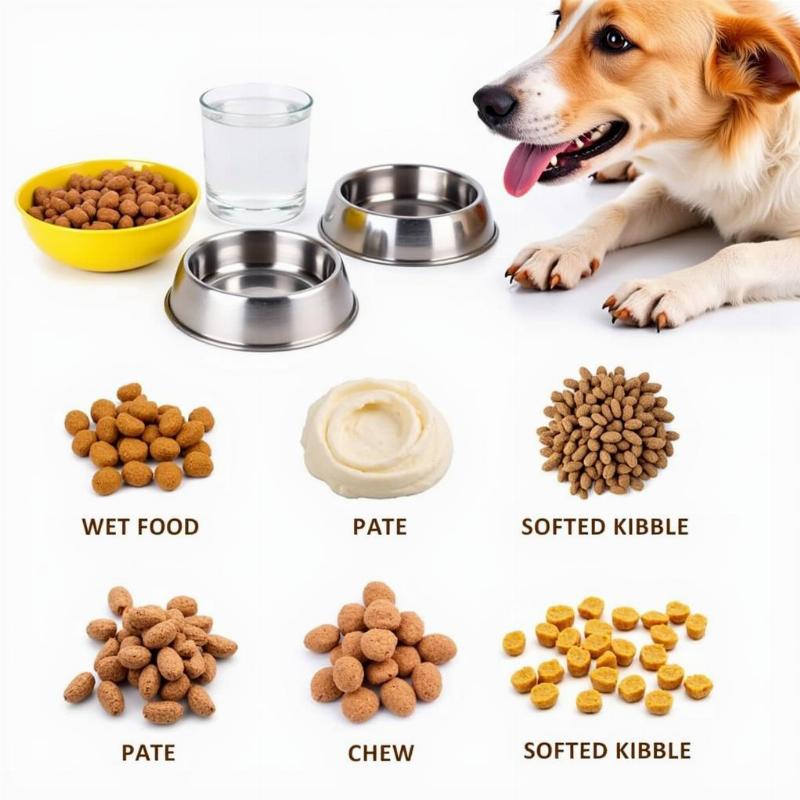Choosing the right food for a dog without teeth can feel daunting. But with a little know-how, you can ensure your toothless companion enjoys delicious and nutritious meals. This guide covers everything from selecting the best textures and ingredients to understanding your dog’s unique nutritional needs. We’ll help you make mealtimes a joyful experience again for your furry friend.
Choosing the Right Texture for Dogs With No Teeth
 Soft Food for Toothless Dogs
Soft Food for Toothless Dogs
The most significant change when feeding a dog without teeth is the texture of their food. Kibble, even small pieces, becomes impossible to chew. Luckily, several options cater specifically to this need:
- Wet Food: Canned wet food is a popular choice, offering a soft, palatable texture easily lapped up. Look for options with high-quality protein sources and minimal fillers.
- Pate: Pate-style wet food offers an even smoother consistency than traditional wet food. This is particularly beneficial for dogs struggling with even soft chunks.
- Soaked Kibble: If your dog prefers kibble, you can soften it by soaking it in warm water or broth. This creates a mushy texture that’s easier to consume. Ensure the kibble is completely softened before serving.
- Homemade Food: For ultimate control over ingredients, consider making homemade food. Pureed vegetables, cooked meats, and rice can be blended to a smooth consistency. Consult your veterinarian for a balanced recipe.
Nutritional Needs of Toothless Dogs
Even without teeth, dogs need a complete and balanced diet. Focus on:
- High-Quality Protein: Essential for maintaining muscle mass, especially in senior dogs who may be losing teeth due to age.
- Fiber: Supports healthy digestion, which can be compromised in toothless dogs who may swallow food without proper chewing.
- Vitamins and Minerals: Ensure your chosen food provides a complete spectrum of vitamins and minerals for overall health and well-being.
- Hydration: Soft food often contains more moisture than kibble, contributing to hydration. Always provide fresh, clean water.
Best Dog Food for Dogs With No Teeth: Top Picks
While specific brands depend on your dog’s individual needs and preferences, here are some general recommendations:
- Brands specializing in senior dog food: These formulas often prioritize softer textures and address age-related nutritional needs.
- High-quality wet food brands: Look for brands with a focus on whole ingredients and balanced nutrition.
- Prescription diets: If your dog has underlying health issues, your vet may recommend a specific prescription diet.
Making Mealtimes Enjoyable
Losing teeth doesn’t mean the end of enjoyable mealtimes. Here are a few tips:
- Elevated Food Bowls: These can make it easier for dogs to reach their food without straining.
- Small, Frequent Meals: Offer smaller portions more frequently to prevent overwhelming your dog.
- Monitor for Choking: Always supervise your dog while eating, especially when transitioning to a new food texture.
Conclusion
Choosing the right “dogs with no teeth food” ensures your canine companion receives the nutrition they need while enjoying their meals. By focusing on texture, nutritional value, and making mealtimes comfortable, you can help your toothless dog thrive.
FAQ
- What can I feed a dog with no teeth? Soft wet food, pate, soaked kibble, and homemade pureed food are all excellent options.
- Is it okay to feed a dog with no teeth dry food? Dry kibble is generally not recommended as it can be difficult and potentially dangerous for toothless dogs to swallow.
- What nutrients are important for dogs without teeth? High-quality protein, fiber, vitamins, and minerals are crucial for maintaining overall health.
- How can I make mealtimes easier for my toothless dog? Use elevated food bowls, offer smaller, frequent meals, and always supervise your dog while eating.
- Should I consult my vet about my dog’s diet? Absolutely. Your vet can recommend the best food based on your dog’s individual needs and health status.
- Can I make homemade food for my dog with no teeth? Yes, homemade pureed food is a great option. Consult your vet for a balanced recipe.
- How can I tell if my dog is enjoying their food? A clean bowl and a happy, content demeanor are good indicators.
Beautdogs.us is your premier resource for dog lifestyle information in the USA. We offer expert advice on dog breeds, care, and products. Whether you’re a seasoned dog owner or just starting your journey, Beautdogs.us is your trusted source for comprehensive and engaging dog care information. Contact us for personalized support: Email: [email protected], Phone: +1 501-555-7529. Visit us at Beautdogs.us for more valuable insights!